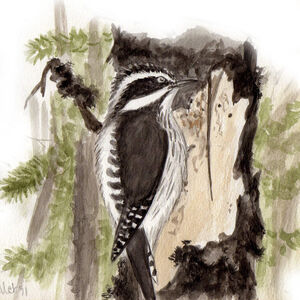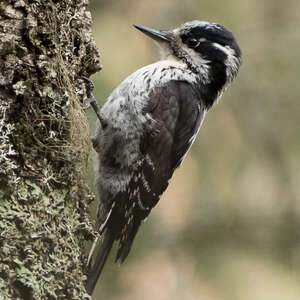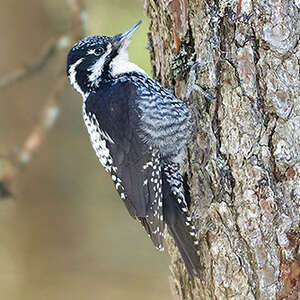Eurasian Three-toed Woodpecker
Picoides tridactylus - Pic tridactyle
Identification
The Eurasian Three-toed Woodpecker is a black and White Woodpecker that is the size of our acorn woodpecker. Its specific name comes from the presence of only 3 toes, 2 in front and 1 in back, instead of 4 like other woodpeckers. The thumb has disappeared.
As the underparts vary from white to black among the subspecies, it will be the local subspecies alpinus that will be described here. The upperparts are black, with a long and narrow white stripe extending from the nape to the rump. On its edges, a mix of white and black entering the scapulars and tertials. The wings are black barred with white on the remiges, which can be seen well in flight when luck is on our side. The tail is black with the outer rectrices heavily marked with white.
The white underparts are heavily barred with black on the sides of the chest and flanks giving a distant impression of gray.
The head is black and white. The black crown is spotted with white in front. The male is distinguished by a bright yellow patch in front, a secondary sexual characteristic. The young male does not have one. The black sides are marked with two white bands, one behind the eye joining the neck, and one from the forehead touching the beak and passing under the eye. The throat is white.
Subspecific information 8 subspecies
- Picoides tridactylus tridactylus (n Europe to the s Ural Mts. to se Siberia and ne China)
- Picoides tridactylus alpinus (c and se Europe to w Ukraine and Romania)
- Picoides tridactylus crissoleucus (n Ural Mts. to e Siberia)
- Picoides tridactylus albidior (Kamchatka Pen.. e Siberia.)
- Picoides tridactylus tianschanicus (e Kazakhstan and w China)
- Picoides tridactylus kurodai (ne China and n Korea)
- Picoides tridactylus inouyei (Hokkaido. Japan.)
- Picoides tridactylus funebris (c China)
Foreign names
- Pic tridactyle,
- Pico tridáctilo,
- pica-pau-tridáctilo,
- Dreizehenspecht,
- háromujjú hőcsik,
- Drieteenspecht,
- Picchio tridattilo,
- tretåig hackspett,
- Tretåspett,
- ďubník trojprstý,
- datlík tříprstý,
- Tretået Spætte,
- pohjantikka,
- picot tridàctil,
- Barkspæta,
- dzięcioł trójpalczasty,
- trīspirkstu dzenis,
- triprsti detel,
- Трёхпалый дятел,
- ミユビゲラ,
- 三趾啄木鸟,
- tretåig hackspett,
- 歐亞三趾啄木,
Voice song and call
The call has a similarity to that of the Great Spotted Woodpecker, but less percussive; a slightly soggy pjic.
The drumming, a form of singing, differs from that of the Great Spotted Woodpecker, and is regular with a very slight acceleration at the end. It lasts 1.3 seconds. You can listen to it on https://xeno-canto.org/.
Various other less typical sounds can be heard during interactions or when in danger.
Habitat
In the Western Palearctic, the species is frequent in old boreal forests to the north of the continent and in high altitude coniferous forests to the south. For example, in France and Switzerland, the Eurasian Three-toed Woodpecker is mainly found in old peatlands. Further east, in Siberia, larch forests are also occupied.
Behaviour character trait
Flight
The Eurasian Three-toed Woodpecker is usually sedentary. However, one can observe alitutinal movements in winter of birds that are most exposed to extreme weather conditions. The flight itself is a typical woodpecker flight. It could be confused with the White-backed Woodpecker, which is partly sympatric, but whose main habitat, the old beech forest, is different.
Dietfeeding habits
The basic diet of the Eurasian Three-toed Woodpecker is insectivorous, which comes as no surprise. The species primarily consumes xylophagous beetle larvae detected under bark.
This food can become almost exclusive in case of major infestations of the forest by cyclically booming Coleoptera, such as the Ips family of Scolytidae. It is these larvae that are fed to the young. Male and female share the space, the lower plane for the former, in order to avoid competing and optimizing search. It is also a lover of sap, which it can reach by beak-piercing bark to reach the wood vessels, especially of conifers. Therefore, the diet is mixed.Reproduction nesting
Breeding occurs late given the habitat and happens between the end of May and June. It is preceded by displays of couples during March.
As in the case of woodpeckers, reproduction is hole-nesting. The couple digs a cavity within a dead or decaying trunk in their territory, at a height of 2 to 10 metres. This can be either in a conifer or a deciduous tree depending on circumstances. The entrance hole is slightly less than 5cm in diameter. The clutch size is variable, usually about 4 eggs. They are incubated for nearly 2 weeks and the young are fed in the nest for around 3 weeks. The few studies that exist suggest a low breeding success, less than 2 young leaving the nest per nest, which is not good for its demography.Geographic range
The Eurasian Three-toed Woodpecker is widespread throughout the eurasian continent at high latitudes, from Scandinavia to Eastern Siberia. A similar species, the Downy Woodpecker, does the same in North America. South of the boreal area, the subspecies alpinus can be found in the mountains of the center and south of the continent, mainly the Alps and the Carpathians. In France, it can only be found in the two departments of the northern Alpine arc, Savoie and Haute-Savoie, and in the highest parts of the Jura massif in the Jura and Ain.
Threats - protection
IUCN conservation status
concern
in the Wild
threatened
evaluated
The Eurasian Three-toed Woodpecker is not globally threatened. However, populations in the south of Europe are rather in difficulty and vulnerable due to climate change and forest exploitation.
In France, due to its rarity, it is hardly known and its population is difficult to calculate, but it is more than likely that it is not doing well.
Sources of information
- IOC World Bird List (v15.1), Gill, F and D Donsker (Eds). 2025-12-07.
Other sources of interest
 Specification sheet created on
25/07/2023 by Jean François
Specification sheet created on
25/07/2023 by Jean FrançoisTranslation by AI Oiseaux.net
© 1996-2025 Oiseaux.net
- Accipitriformes
- Aegotheliformes
- Anseriformes
- Apodiformes
- Apterygiformes
- Bucerotiformes
- Caprimulgiformes
- Cariamiformes
- Casuariiformes
- Charadriiformes
- Ciconiiformes
- Coliiformes
- Columbiformes
- Coraciiformes
- Cuculiformes
- Eurypygiformes
- Falconiformes
- Galliformes
- Gaviiformes
- Gruiformes
- Leptosomiformes
- Mesitornithiformes
- Musophagiformes
- Nyctibiiformes
- Opisthocomiformes
- Otidiformes
- Passeriformes
- Pelecaniformes
- Phaethontiformes
- Phoenicopteriformes
- Piciformes
- Podargiformes
- Podicipediformes
- Procellariiformes
- Psittaciformes
- Pterocliformes
- Rheiformes
- Sphenisciformes
- Steatornithiformes
- Strigiformes
- Struthioniformes
- Suliformes
- Tinamiformes
- Trogoniformes
































